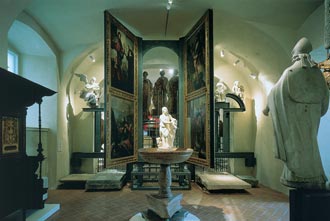Permanent Display 14. The Interior of the Cathedral
 In the first half of the 17th century, two fatal fires hit the Cathedral, causing it grievous damage, just after, for the first time in its history, it had obtained a great bell-tower. According to an account of a canon of the time, Juraj Ratkaj, the cathedral vault fell in, “crushing the choir to pieces, the bishop’s throne, five altars below the choir”, and so on.
In the first half of the 17th century, two fatal fires hit the Cathedral, causing it grievous damage, just after, for the first time in its history, it had obtained a great bell-tower. According to an account of a canon of the time, Juraj Ratkaj, the cathedral vault fell in, “crushing the choir to pieces, the bishop’s throne, five altars below the choir”, and so on.
At the end of the 17th century, the Cathedral was enriched with many new altars. The most important were certainly the altar of St Mary and the altar of St Ladislav. At the beginning of the 18th century, the Cathedral had its first marble altars. They were created by Slovene sculptors or Italian artists, among whom the most well known was Francesco Robba, who had contracted to do four altars for the Cathedral. He is reliably attributed the altar of the Holy Cross, which during the restoration of the Cathedral was taken to Križevci. Many revered men of the church were buried in the Cathedral. Their graves were marked by stones with carved inscriptions and figural motifs. After the Counter Reformation the slabs were placed on the floor, to be walked upon as a sign of humility. During the restoration of the Cathedral all these stones were removed from the interior.
Slavko Šterk

